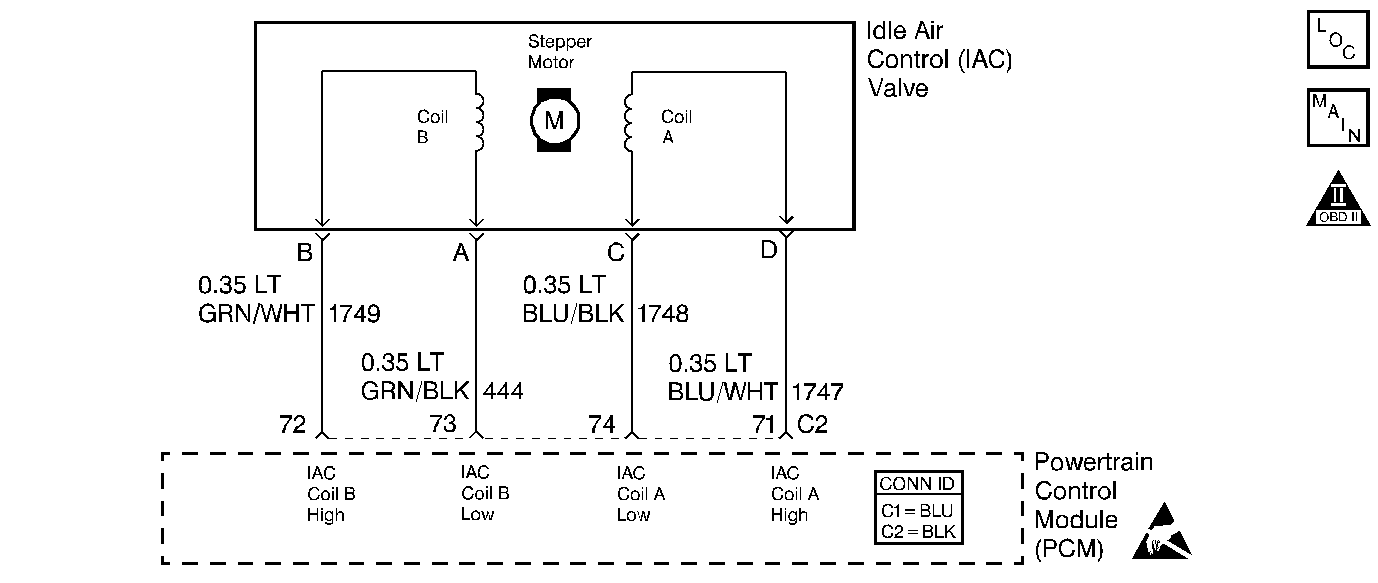
Circuit Description
The PCM controls the air entering into the engine with an idle air control (IAC) valve. To increase the idle RPM, the PCM commands the pintle inside of the IAC valve away from the throttle body seat. This allows more air to bypass through the throttle blade. To decrease the RPM, the PCM commands the pintle towards the throttle body seat. This reduces the amount of air bypassing the throttle blade. A scan tool will read the IAC valve pintle position in counts. The higher the counts, the greater the airflow that bypasses the throttle blade.
Conditions for Running the DTC
| • | DTCs P0105, P0107, P0108, P0112, P0113, P0117, P0118, P0122, P0123, P0125, P0131, P0132, P0133, P0134, P0201, P0202, P0203, P0204P0335, P0341, P0342, P0440, P0442, P0446, P0480, P0502, P0503, P0601, P0602, P1133, and P1441 not set |
| • | The BARO is more than 72 kPa. |
| • | The engine coolant temperature ( ECT) is more than 40°C (104°F). |
| • | The engine has been running more than 20 seconds. |
| • | The throttle position (TP) angle is less than 1 percent. |
Conditions for Setting the DTC
| • | The engine RPM is below desired RPM by more than 100 RPM for 19 seconds. |
| • | The IAC command is more than 145 counts. |
Action Taken When the DTC Sets
| • | The malfunction indicator lamp (MIL) will illuminate after two consecutive ignition cycles in which the diagnostic runs with the malfunction present. |
| • | The PCM records the operating conditions present at the time the diagnostic fails. This information stores in the Freeze Frame and Failure Records buffers. |
| • | A history DTC stores. |
| • | The coolant fan turns ON. |
Conditions for Clearing the MIL/DTC
| • | The MIL will turn OFF after three consecutive ignition cycles in which the diagnostic runs without a fault. |
| • | A history DTC will clear after 40 consecutive warm up cycles without a fault. |
| • | Use a scan tool to clear the DTCs. |
Diagnostic Aids
| • | Inspect the IAC valve electrical connection for proper mating. |
| • | Inspect the wiring harness for damage. |
| • | Inspect the throttle stop screw for signs of tampering. |
| • | Inspect the throttle linkage for signs of binding or excessive wear. |
| • | A slow, or unstable idle may be caused by one of the following conditions: |
| - | A fuel system that is too rich or too lean |
| - | Foreign material in the throttle body bore or in the air induction system |
| - | A leaking or restricted intake manifold |
| - | An excessive engine load -- Check for seized pulleys, pumps, or motors on the accessory drive. |
| - | Overweight engine oil |
| • | Refer to Rough, Unstable, or Incorrect Idle and Stalling . |
Test Description
The number below refers to the step number on the diagnostic table:
Step | Action | Values | Yes | No | ||||||||
|---|---|---|---|---|---|---|---|---|---|---|---|---|
1 | Did you perform the Powertrain On Board Diagnostic (OBD) System Check? | -- | ||||||||||
2 | Are any other DTCs set? | -- | ||||||||||
3 |
Does Engine Speed remain within the Desired Idle range for each RPM command? | ±50 RPM | Go to Diagnostic Aids | |||||||||
4 |
Does the node lamp cycle? | -- | ||||||||||
5 |
Did you find and correct the condition? | -- | ||||||||||
6 | Visually and physically inspect for the following conditions:
Did you find and correct the condition? | -- | ||||||||||
7 |
Did you find and correct the condition? | -- | ||||||||||
8 | Replace IAC valve. Refer to Idle Air Control Valve Replacement . Did you complete the replacement? | -- | -- | |||||||||
9 |
Did you find and correct the condition? | -- | ||||||||||
|
Important: : Replacement PCM must be programmed. Refer to Powertrain Control Module Replacement/Programming Replace the PCM. Refer to Powertrain Control Module Replacement . Did you complete the replacement? | -- | -- | ||||||||||
11 |
Does Engine Speed remain within the specified value of Desired Idle for each RPM command? | ±50 RPM | System OK |
